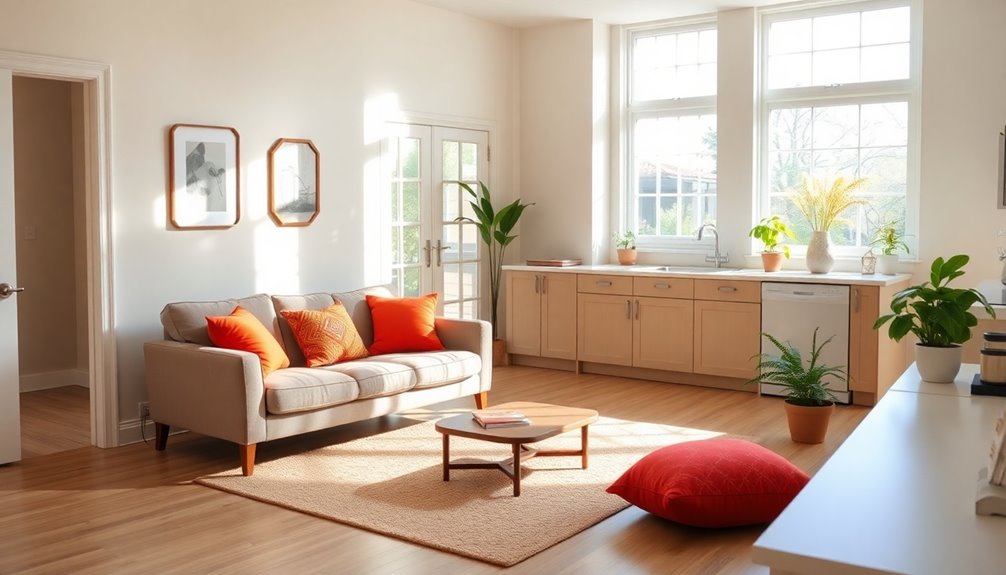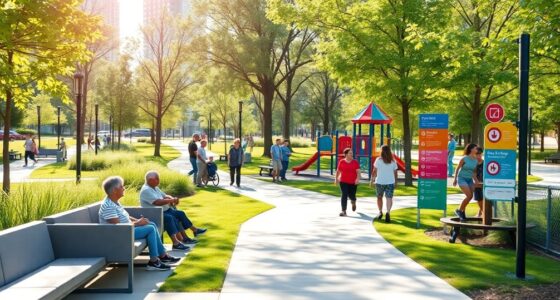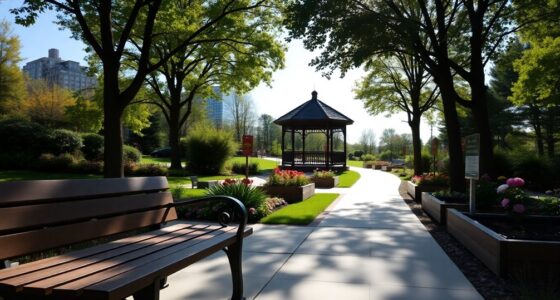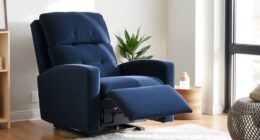To create an age-friendly home, focus on accessibility and safety. Start with no-step entries and wider doorways for easy navigation. Install bright, glare-free lighting with motion sensors to illuminate paths. Use lever-style door handles and non-slip flooring to minimize trip hazards. Add grab bars in bathrooms and opt for walk-in showers for safer bathing. Smart home tech, like voice-activated assistants, can enhance convenience. These design features guarantee comfort and independence, and there's so much more to explore!
Key Takeaways
- Implement no-step entries and wider doorways to accommodate mobility devices for easy access throughout the home.
- Utilize bright, glare-free lighting with motion sensors to enhance visibility and safety in key areas.
- Install grab bars in bathrooms and non-slip flooring to prevent falls and ensure safer navigation.
- Incorporate lever-style door handles and rocker switches for improved usability and accessibility for seniors.
- Design hallways at least 36 inches wide and eliminate thresholds for smoother movement and navigation.
Understanding the Principles of Universal Design for Home Modifications
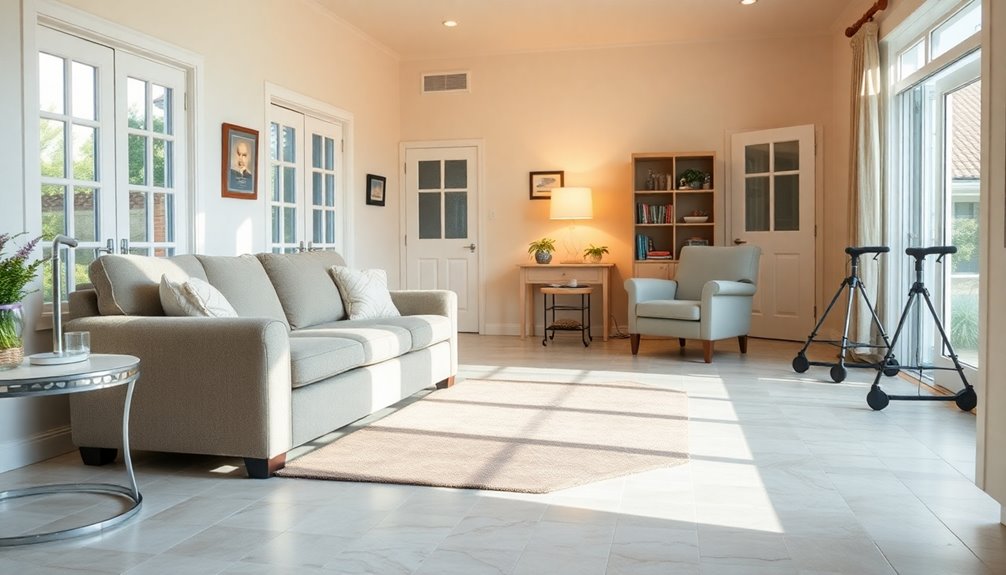
When you think about making your home more age-friendly, understanding the principles of universal design is essential.
Universal design focuses on creating spaces that enhance accessibility for everyone, regardless of age or ability. This means considering home modifications like no-step entries and wider doorways, which accommodate mobility devices and eliminate stair-related risks. Additionally, incorporating home security systems can provide peace of mind and safety for seniors. Furthermore, ensuring that the home is equipped with a reliable heat pump system can improve indoor air quality and comfort for residents.
Features such as lever-style door handles and rocker light switches can greatly improve usability for older adults. Effective lighting, including bright, glare-free fixtures and motion-sensor lights, enhances visibility and reduces accident risks. Additionally, incorporating efficient storage strategies can help maintain a clutter-free environment, promoting both safety and peace of mind.
Creating Safe and Accessible Entryways for the Elderly

Creating safe and accessible entryways for the elderly is essential for enhancing their independence and mobility. To achieve this, consider a no-step design that allows easy access for those with mobility limitations, including walkers or wheelchairs.
Wider doorways and hallways guarantee smooth navigation, while non-slip flooring materials help prevent dangerous slips and falls, enhancing safety.
Adding convenient landing places, like small tables or benches, provides secure surfaces for placing items during entry or exit, reducing the risk of losing balance.
These thoughtful modifications not only promote safety but also empower seniors to move freely in and out of their homes, fostering a sense of autonomy and comfort in their daily lives.
Installing Proper Lighting
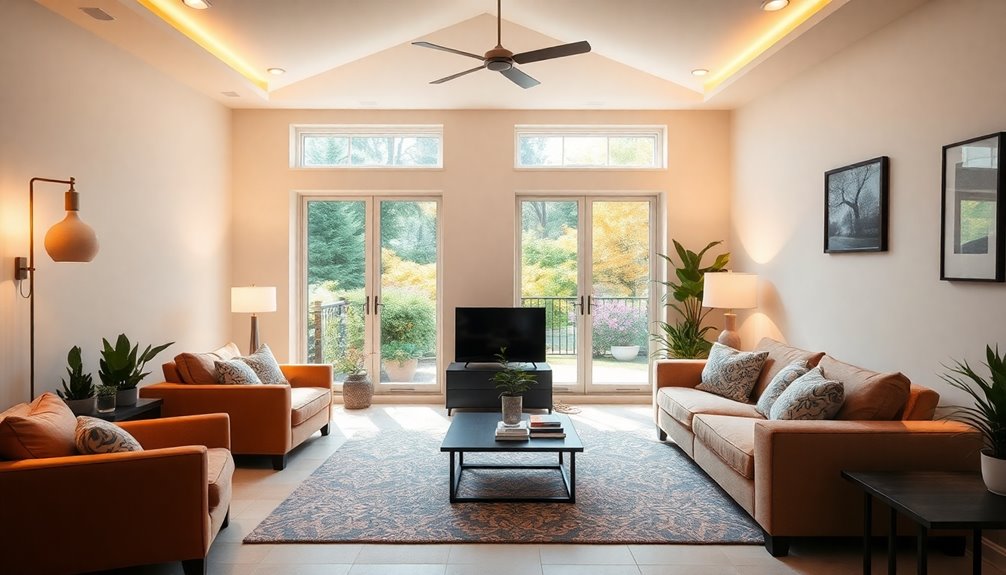
Proper lighting is essential for ensuring that seniors can navigate their homes safely and confidently. Bright, glare-free fixtures in entryways and key areas enhance visibility and reduce the risk of falls. Consider installing motion-sensor lights that automatically illuminate paths as you approach, helping prevent accidents in poorly lit areas. A thorough lighting strategy should include both ambient and task lighting, ensuring high-traffic areas and specific workspaces are well-lit for aging eyes. Additionally, incorporating HEPA filters in air purifiers can further improve indoor air quality, complementing the safety measures provided by proper lighting. Regularly checking filters is crucial to maintain the efficiency of air purifiers, ensuring the best air quality for seniors. LED fixtures are ideal due to their longevity and low maintenance needs, providing consistent lighting without frequent bulb changes. Additionally, using contrasting color lighting, like LED strip lights along stair edges, can improve visibility and help you navigate stairways safely. Investing in proper lighting makes a significant difference in home safety, just as consistent maintenance of air purifiers can significantly enhance indoor air quality for a healthier living environment.
Adding Convenient Landing Places
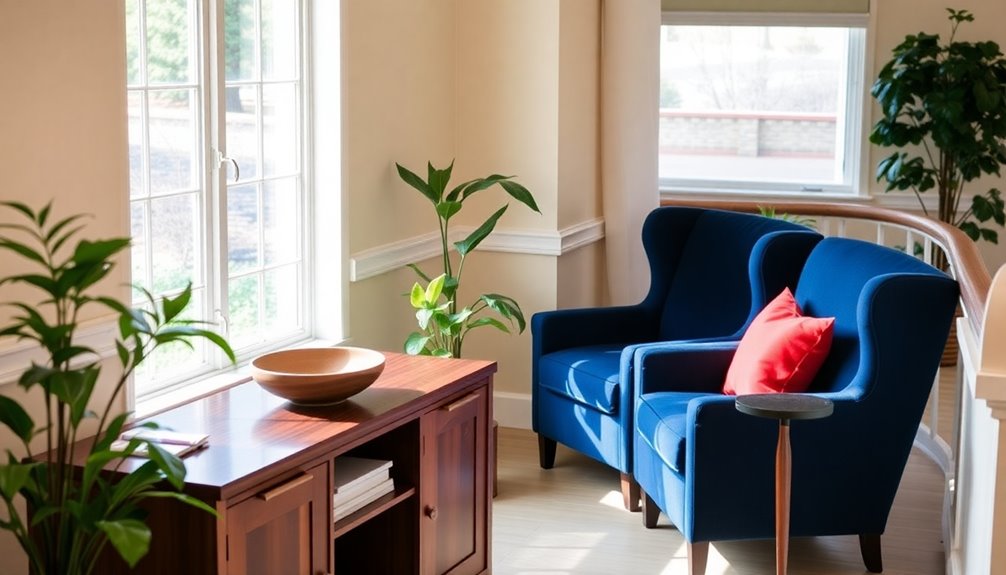
When you think about enhancing your entryway, consider adding convenient landing places like small tables or benches.
These surfaces give you a secure spot to set down items, making it easier to manage your belongings as you enter or exit your home.
Not only do they improve safety and convenience, but they also add a touch of style to your space.
Safe Surfaces for Items
Adding convenient landing places near entryways can make a world of difference for seniors as they navigate their homes. By creating safe surfaces, like small tables or benches, you provide secure spots for items like keys and groceries.
This reduces the risk of dropping belongings or losing balance while entering or exiting. These age-friendly landing areas also help prevent clutter, minimizing potential trip hazards by keeping items off the floor.
With strategically placed landing zones, you support smoother shifts from outside to inside, making it easier for seniors to manage their belongings and maintain stability.
Ultimately, such enhancements considerably boost safety and accessibility, contributing to a more comfortable living environment as you age. Moreover, incorporating essential oils for respiratory health into the home can further promote well-being and comfort for seniors.
Enhancing Entryway Convenience
Creating safe surfaces for items is just the beginning of enhancing entryway convenience.
By adding convenient landing places like small tables or benches near your entryway, you provide secure spots for placing items as you enter or exit your home. This reduces the risk of dropping things or losing your balance. Additionally, incorporating best home security systems can enhance your overall safety and peace of mind while navigating your space. Furthermore, considering an energy efficiency evaluation can help to identify areas in your home that may need improvement, contributing to a more comfortable environment.
These landing areas not only support smoother changes but also promote your independence by making it easier to navigate your space. Moreover, they offer a resting place, allowing you to pause and regain your balance before moving further inside.
Make certain these spots are easily accessible and free from clutter to create a safer, more welcoming entryway, greatly reducing the potential for falls, which are a leading cause of injury among older adults. Additionally, incorporating home improvement techniques can further enhance safety and comfort in your entryway.
Enhancing Mobility Throughout the Home

To enhance mobility throughout your home, consider simple yet effective modifications that accommodate the needs of seniors.
Addressing mobility limitations can make a significant difference in daily life. Here are four key improvements:
- Upgrade door hardware to lever-style handles for easier access.
- Install slip-resistant flooring to minimize trip hazards and reduce fall risks.
- Eliminate thresholds between rooms to create smoother passages for walkers or wheelchairs.
- Provide ample space in hallways, ensuring they're at least 36 inches wide for safe navigation.
Designing Elder-Friendly Staircases

While traversing stairs can be a challenge for many seniors, designing elder-friendly staircases can greatly enhance safety and accessibility.
Start by installing handrails on both sides of the staircase for maximum support. Make certain they've a comfortable grip diameter to suit older adults. Proper installation is crucial to ensure the handrails are securely attached and provide reliable support. Additionally, the use of assistive devices can further promote safe navigation of staircases for seniors.
Use non-slip materials on stair surfaces to drastically reduce slip and fall risks. Adequate lighting is essential, so consider overhead lights and motion-sensor options to improve visibility, especially at night.
Opt for contrasting colors for handrails and stair treads to make them more visible.
Finally, adhere to minimum rise and run dimensions, making sure the stairs aren't too steep and are easier to navigate for those with mobility challenges. Additionally, incorporating natural elements such as wood or stone in the staircase design can create a calming atmosphere that promotes relaxation.
Adapting Bathrooms for Increased Safety for the Elderly
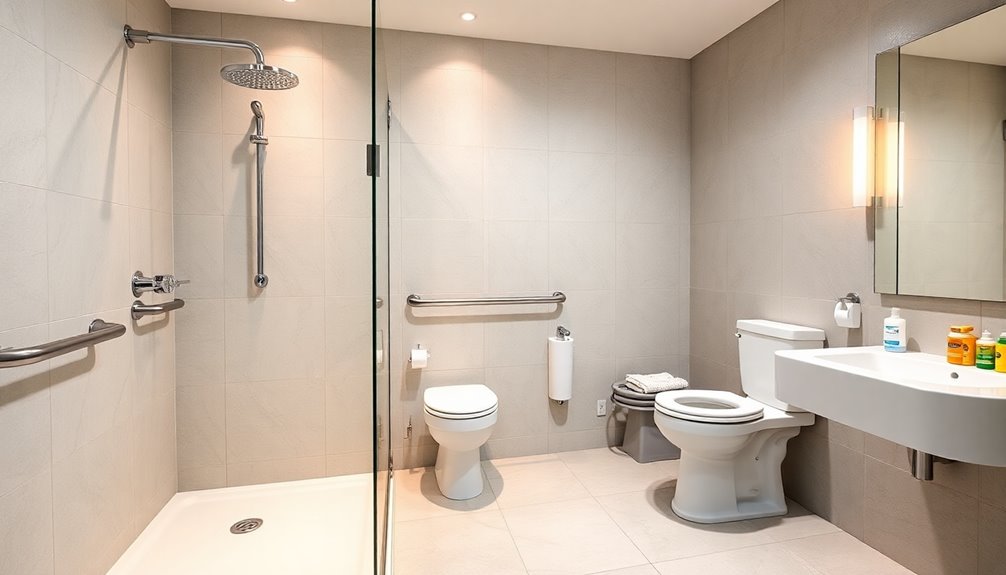
When it comes to bathroom safety for seniors, strategic grab bar placement can make a big difference in preventing falls.
You'll also want to take into account non-slip flooring solutions and accessible shower features to create a safer environment.
These simple upgrades can greatly enhance comfort and stability in the bathroom.
Essential Grab Bar Placement
Installing grab bars in your bathroom can greatly enhance safety for seniors. Proper placement guarantees ideal support, allowing for safe transfers and stability.
Here are key locations for grab bars:
- Near the toilet – A grab bar helps with sitting and standing.
- Inside the shower or bathtub – Essential for preventing slips when entering or exiting.
- Outside the shower or bathtub – Provides extra support while drying off or dressing.
- Along the walls adjacent to sinks – Aids in balance when washing hands.
Make certain the grab bars can support at least 250 pounds and are securely anchored.
Opt for a diameter of 1.25 to 1.5 inches for comfort, and consider contrasting colors for better visibility to enhance safety.
Non-Slip Flooring Solutions
To create a safer bathroom environment for seniors, choosing the right non-slip flooring is crucial. Non-slip flooring solutions like textured vinyl, rubber, and cork can greatly reduce the risk of slips and falls. Installing slip-resistant tiles or coatings enhances safety, especially on wet surfaces. Additionally, it's essential to consider how emotional well-being can be impacted by a safe living environment as it can help reduce anxiety and promote comfort. Implementing eco-friendly practices in home design can further enhance the quality of life for seniors while also being mindful of the environment.
Here's a quick comparison of flooring options:
| Flooring Type | Safety Features | Maintenance Needs |
|---|---|---|
| Textured Vinyl | High traction | Regular cleaning |
| Rubber | Water-resistant | Occasional deep cleaning |
| Low-Pile Carpet | Non-slip backing | Check for flatness |
Additionally, using contrasting colors can alert seniors to changes in elevation, providing a safer walking surface. Regular maintenance guarantees these solutions remain effective. It's also important to consider dilution guidelines for any essential oils used in the bathroom to avoid irritation or allergic reactions.
Accessible Shower Features
Creating an accessible shower can considerably enhance safety for seniors, especially those with mobility challenges.
By implementing essential accessible shower features, you can promote independence while reducing the risk of falls.
Consider these key elements:
- Walk-in showers eliminate high bathtub walls, making entry and exit safer.
- Grab bars installed inside and around the shower offer vital support and stability.
- Adjustable handheld showerheads allow easy control of water flow and direction, catering to varying mobility needs.
- Lever-style faucets are easier to operate, reducing strain on grip strength while adjusting temperature.
Don't forget to install non-slip flooring to minimize slipping hazards, ensuring a safer bathing experience for seniors facing mobility limitations.
Optimizing Lighting for Aging Eyes
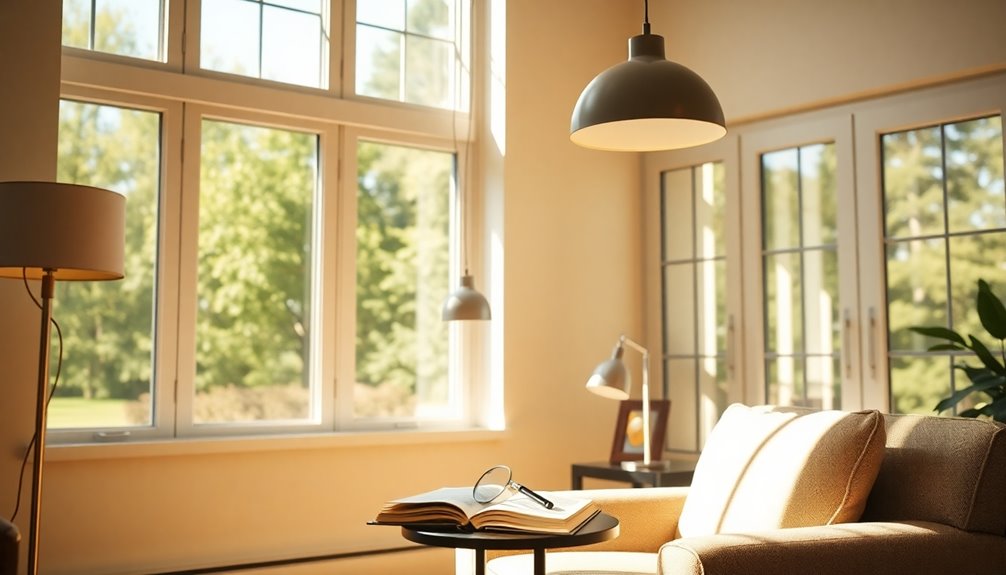
As you age, your eyes require more light to see clearly, making it essential to improve lighting in your home.
High-traffic areas should be bright and glare-free to enhance safety and minimize accidents. Aim for a color temperature between 2,700 and 3,000 Kelvin for ideal visibility.
Task lighting, like adjustable lamps, can provide focused illumination for activities such as reading or cooking, reducing strain on your aging eyes.
Consider installing indirect lighting to eliminate harsh shadows and glare, which can create trip hazards.
Additionally, motion-sensor lights in hallways and entryways automatically illuminate spaces as you approach, further enhancing safety and reducing the risk of falls.
With proper lighting, you'll enjoy greater comfort and security in your home.
Selecting Senior-Friendly Furniture
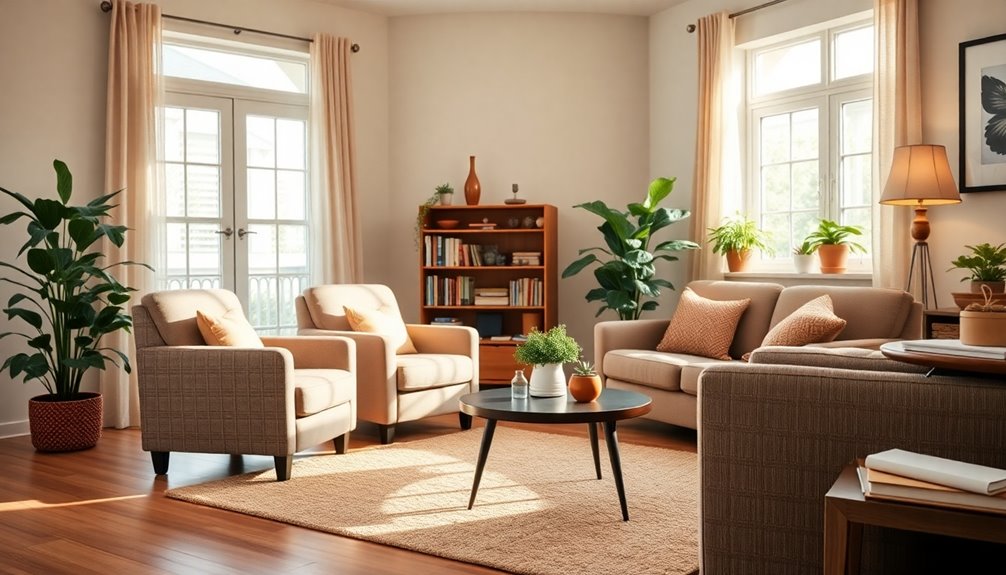
Good lighting can greatly enhance your home's safety, but the right furniture plays an essential role in creating an age-friendly environment.
When selecting senior-friendly furniture, consider these key features to address mobility limitations and enhance comfort:
- Stable Base: Choose pieces with a wide base for stability, preventing tipping when sitting or standing.
- Cushioned Support: Opt for chairs and sofas with cushioned seats and backrests that offer lumbar support for extended comfort.
- Adjustable Heights: Select tables and desks that can be adjusted to accommodate different seating arrangements.
- Ease of Use: Look for lever-style handles and easy-to-pull drawers to reduce strain for those with limited hand strength.
These choices not only improve safety but also create a welcoming and functional living space for seniors.
Implementing Smart Home Technology for Ease of Use
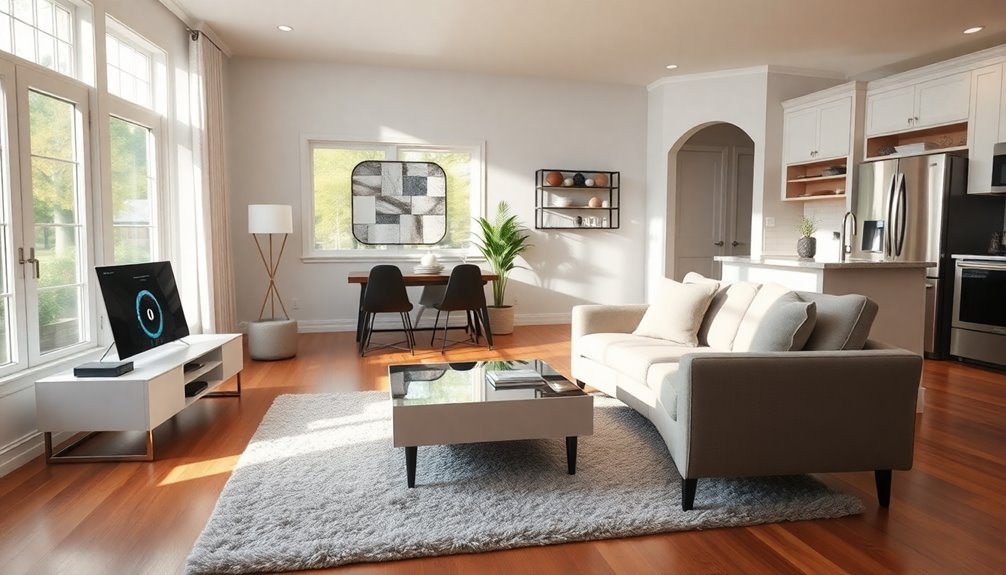
Implementing smart home technology can greatly simplify daily tasks for seniors, making their living environments safer and more manageable.
With voice-activated assistants, you can control lights, thermostats, and appliances hands-free, enhancing convenience.
Automated lighting systems with motion sensors illuminate rooms as you enter, reducing the risk of falls and improving visibility.
Smart doorbells with video capabilities let you see who's at the door without getting up, promoting safety and peace of mind.
Home monitoring systems can alert caregivers or family members during emergencies, ensuring timely assistance.
Plus, devices like smart plugs and programmable thermostats help you manage energy use efficiently, providing comfort and saving money.
Embracing these technologies can truly transform your living experience.
Frequently Asked Questions
How to Make a Home More Senior Friendly?
To make your home more senior-friendly, start by installing grab bars in bathrooms and near stairways to prevent falls.
Replace traditional door knobs with lever-style handles and use rocker light switches for easier operation.
Enhance visibility with adequate lighting, especially in high-traffic areas, and consider non-slip flooring materials to reduce hazards.
Finally, guarantee wider doorways and a single-level layout to facilitate easy movement for those using walkers or wheelchairs.
What Is the Most Desirable Home Design for Aging in Place?
The most desirable home design for aging in place focuses on convenience and safety.
You'll want single-level layouts to avoid stairs, and wider doorways for easy navigation with mobility aids.
Accessible bathrooms with grab bars and curbless showers enhance usability.
Simplifying daily tasks with lever-style door handles and rocker switches makes life easier.
Plus, verify your home has ample natural light to improve visibility and reduce trip hazards as your vision changes.
How to Design a House for Seniors?
Designing a home for seniors can feel like crafting a cozy nest for cherished memories.
Start by ensuring wide doorways and hallways for easy navigation, especially if you're using a walker or wheelchair. Opt for lever-style door handles and rocker switches to make things simpler.
Keep all living spaces on a single level to avoid stairs, and use non-slip flooring to reduce trip hazards.
Finally, don't forget grab bars in key areas for extra support.
How to Design for Elderly People?
When designing for elderly people, focus on creating a safe and accessible environment.
Use wide doorways and hallways to accommodate mobility aids. Opt for lever-style door handles and rocker switches for easier operation.
Install grab bars in critical areas, and choose non-slip flooring to minimize fall risks.
Guarantee bright, glare-free lighting is available, particularly in high-traffic areas.
Conclusion
Incorporating these age-friendly design secrets can greatly enhance the comfort and safety of any senior home. By focusing on universal design principles, you’ll create a space that not only meets the needs of the elderly but also promotes independence. Isn’t it time you transformed your home into a haven for aging loved ones? Embrace these modifications, and watch how a few thoughtful changes can make a world of difference in their daily lives. In addition to improving accessibility, incorporating innovative design solutions for aging can significantly enhance the overall aesthetic of your home. Features such as non-slip flooring, well-placed grab bars, and ample lighting can seamlessly blend functionality with style. By prioritizing these adjustments, you not only create a safer environment but also foster a sense of dignity and self-reliance for your aging loved ones.
